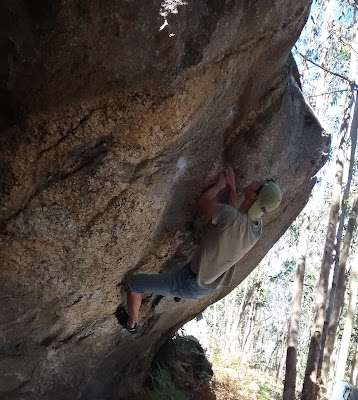Everyone speaks English these days, right? So will the French understand the following climbing terms?
Arete ✓
An “arête”
is a “ridge” in French. And in English too, the
word is written with that little funny accent that they call a circumflex – according to Oxford dictionary anyway.
Beta ✗
Although
more terms get into French thanks to the supremacy of American English, this
term supposedly coined by Texan climber Jack Mileski in 1981 is unlikely to
replace its French equivalent, méthode.
Interestingly, method is probably a rare example of jargon that was first used
by boulderers. In the context of climbing, it was first used by the Bleausards.
Crux ✓
This is the
Latin word for “cross”, which for Christians, is synonymous of “crucifixion”. The
French share with the Italians the belief that their language is more Latin
than the Pope’s. So while French climbers will certainly know and use this
term, they will firmly believe it is a French word. And wrongly so: the word is
not in their dictionary and was probably borrowed to English. Incidentally, to tick a problem is faire une croix in French (to make a cross mark) and a tick list is a carnet de croix (cross mark book).
Deadpoint ✗
Supposedly
first used by John Gill in 1969, this very useful word started
to infiltrate the French climbing jargon only recently. It would be a great addition
to French climbing lingo as it has no equivalent.
Dyno ✓
Short
English words tend to be perceived as cool in French, especially if they look
like something familiar, which is the case of this shortening of mouvement dynamique. Having said that,
the French did not wait for John Gill to practice dynos – and they could have waited a long time since
he’s never travelled to Font. Before the Internet was
invented, dynos were called jetés
(throws).
FA ✓
Thanks to the popularity of web platforms promoting the competitive way of life, everyone is aware of the importance of first ascents. Yet it is
unlikely that the English term will replace the French term. Indeed, FA are
called openings (ouvertures) in
French, because after all, FAs are about sharing.
Figure-4 ✗
The name of
this climbing move was supposedly coined in 1982 by British climber John Arran.
But the French don’t know who John Arran was (er… is?). They do know Tony Yaniro
however, who popularised this move – so in French, this is called Le Yaniro.
Flash ✓
French speaking climbers and
boulderers climb à vue (on sight), après travail (red point) or, like in
English, flash. All three expressions
are used as adverbs, not as verbs, duh.
Font ✗
This popular nickname in not used
by the French. As far as the Bleausards are concerned, Fontainebleau has always
been called Bleau – pronounced a bit
like “blow”. Why would you change the name of your pond? Plus, everyone knows that a font is a type of printing characters, right?
Gaston ✗
This was a popular baby name in the French city of Marseilles in the 1920s. So it was the name that Mr and Mss Rebuffat chose for
their son when he was born. He later climbed lots of mountains including the
Grandes Jorasses and the Annapurna. Despite this fame, the French call the gaston move a shoulder move (épaule). Shameful really.
Highball ✓
According to Sherman, the term “highball” derives
from the similarity between a highball climb and a highball cocktail glass.
Both should be enjoyed with moderation. The French know what moderation is, but they
usually think highballs have something to do with balls. And getting high.
Mantle ✗
French climbers don’t climb on
their mantelshelf, they prefer to “re-establish” themselves, hence the climbing
term réta (for rétablissement). Réta Authenac,
for instance, is a famous 6b mantel of the Cuvier sector in Font, first climbed
by Charles Authenac, in the 1930s, in his hard walking boots. He originally
graded it 5+ but it must have taken him more than one session.
Rose move ✗
The English
term derives from the world known French sports route La Rose et le Vampire, at
Buoux. The French may feel honoured by this English choice of words, but they
prefer to use the word derviche tourneur,
or derviche for short, which in Farsi
language refers to someone treading a Sufi Muslim ascetic path in poverty and
austerity. That’s because derviches from the Mevlevi Order perfom a famous
whirling dance, hence the name given to this move.
V-scale ✗
John Sherman was born in 1959. The First Fontainebleau guidebook
was published in 1945. Do your maths and you’ll understand why Font grades take
precedence.
Voilà!
 |
| Réta Authenac, in bas Cuvier, a famous mantle from the 1930s |













